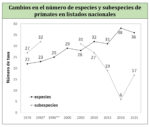Taxonomía de los primates de Colombia: cambios en los últimos veinte años (2000–2019) y anotaciones sobre localidades tipo
Sebastián García-Restrepo, Sebastián O. MontillaColombia es uno de los países con mayor riqueza de primates en el mundo. Sin embargo, el número e identidad de las especies ha sido un tema debatido a lo largo de los años. Las primeras descripciones de primates colombianos se remontan a expediciones posteriores a la conquista española. A esto se sumaron las primeras revisiones taxonómicas de géneros y especies en la primera mitad del siglo XX, a partir de literatura y especímenes de museo. Con el objetivo de unificar la información taxonómica de los primates no humanos del país, realizamos una revisión de literatura enfocada en aquellos aportes que han llevado a cambios en los arreglos taxonómicos y nomenclaturales de los últimos 20 años. Además, reunimos información sobre los taxa con localidad tipo en Colombia a partir de revisiones de las descripciones originales. En total, reconocemos la presencia de 36 especies y 17 subespecies, donde los mayores cambios se han dado en los géneros Cebus y Aotus. Reportamos ocho especies endémicas, y 25 taxa con localidades tipo en el país. Consideramos que, de acuerdo con revisiones recientes, las poblaciones del género Cacajao en el país corresponden a C. ouakary (Spix 1823) y, ante la ausencia de evidencia molecular, barreras geográficas y diferenciación fenotípica, indicamos a Pithecia milleri como subpespecie de P. hirsuta (Spix 1823), y a Cheracebus lucifer y C. medemi como subespecies de C. torquatus (Hoffmannsegg, 1807). Finalmente, proponemos el uso de subgéneros para representar las relaciones evolutivas en Saguinus (Leontocebus) y Callicebus (Plecturocebus, Cheracebus).
Taxonomy of Colombian primates: changes in the last twenty years (2000–2019) and some taxonomic notes. Colombia is among the countries with the greatest richness of primates in the world. However, the number and identity of species has been a debated topic over the years. The first descriptions of Colombian primates date back to expeditions after the Spanish conquest. Later, the first taxonomic reviews of genera and species were published in the first half of the 20th century, based on literature and museum specimens. To unify the taxonomic information of non-human primates of the country, we conducted a literature review focused on those contributions that have led to changes in the taxonomic and nomenclatural arrangements of the last 20 years. Also, we collected information on taxa with type locality in Colombia from revisions of the original descriptions. We recognize the presence of 36 species and 17 subspecies, where the greatest changes have occurred in the genera Cebus and Aotus. We report 8 endemic species and 25 taxa with type localities in the country. Furthermore, we consider that, according to recent reviews, the populations of the genus Cacajao in the country correspond to C. ouakary (Spix 1823) and, in the absence of molecular evidence, geographic barriers, and phenotypic differentiation, we indicate Pithecia milleri as a subspecies of P. hirsuta (Spix, 1823), and Cheracebus lucifer and C. medemi as subspecies of C. torquatus (Hoffmannsegg, 1807). Finally, we propose the use of subgenera to represent the evolutionary relationships in Saguinus (Leontocebus) and Callicebus (Plecturocebus, Cheracebus).
